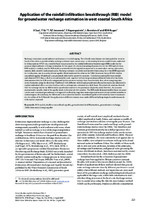| dc.contributor.author | Xianfeng, Sun | |
| dc.contributor.author | Jovanovic, Nebo Z. | |
| dc.contributor.author | Kapangaziwiri, Evison | |
| dc.contributor.author | Brendonck, Luc | |
| dc.contributor.author | Bugan, Richard Domain Hunter | |
| dc.date.accessioned | 2013-11-14T11:55:58Z | |
| dc.date.available | 2013-11-14T11:55:58Z | |
| dc.date.issued | 2013 | |
| dc.identifier.citation | Xianfeng, Sun, et al. (2013). Application of the rainfall infiltration breakthrough (RIB) model for groundwater recharge estimation in west coastal South Africa. Water SA, 39(4): 221-230 | en_US |
| dc.identifier.issn | 0378-4738 | |
| dc.identifier.uri | http://hdl.handle.net/10566/815 | |
| dc.description.abstract | Recharge estimation in arid and semi-arid areas is very challenging. The chloride mass balance method applied in western
South Africa fails to provide reliable recharge estimates near coastal areas. A relationship between rainfall events and water
level fluctuations (WLF) on a monthly basis was proposed in the rainfall infiltration breakthrough (RIB) model for the
purpose of groundwater recharge estimation. In this paper, the physical meaning of parameters in the CRD and previous
RIB models is clarified, and the RIB model is reviewed with the algorithm improved to accommodate various time scales,
namely, daily, monthly and annual scales. Recharge estimates on a daily and monthly basis using the revised RIB approach
in 2 study areas, one in a sandy alluvial aquifer (Riverlands) and the other in the Table Mountain Group (TMG) shallow
unconfined aquifer (Oudebosch), are presented, followed by sensitivity analysis. Correlation analysis between rainfall
and observed WLF data at daily scale and monthly scale, together with recharge estimates obtained from other methods,
demonstrates that the RIB results using monthly data are more realistic than those for daily data, when using long time
series. Scenarios using the data from Oudebosch with different rainfall and groundwater abstraction inputs are simulated to
explore individual effects on water levels as well as recharge rate estimated on a daily basis. The sensitivity analysis showed
that the recharge rate by the RIB model is specifically sensitive to the parameter of specific yield; therefore, the accurate
representative specific yield of the aquifer needs to be selected with caution. The RIB model demonstrated in these two cases
can be used to estimate groundwater recharge with sufficiently long time series of groundwater level and rainfall available in
similar regions. In summary, the RIB model is best suited for shallow unconfined aquifers with relatively lower transmissiv
-
ity; the utility of the RIB model for application in different climatic areas under different hydrogeological conditions needs
to be further explored. | en_US |
| dc.language.iso | en | en_US |
| dc.publisher | Water Research Commission | en_US |
| dc.subject | RIB model | en_US |
| dc.subject | Shallow unconfined aquifer | en_US |
| dc.subject | Groundwater-level fluctuation | en_US |
| dc.subject | Groundwater recharge | en_US |
| dc.subject | Table Mountain Group aquife | en_US |
| dc.title | Application of the rainfall infiltration breakthrough (RIB) model for groundwater recharge estimation in west coastal South Africa | en_US |
| dc.type | Article | en_US |
| dc.privacy.showsubmitter | false | |
| dc.status.ispeerreviewed | true | |
| dc.description.accreditation | Web of Science | en_US |

